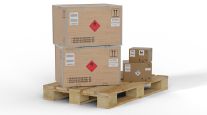Senior Reporter
PHMSA’s Final Rule Offers Guidance on Return of Hazmat From Retailers
This story appears in the April 4 print edition of Transport Topics.
The Pipeline and Hazardous Materials Safety Administration has announced its final rule offering guidance for return of hazardous materials from retailers back to manufacturers, suppliers and distribution facilities.
The agency’s hazmat “reverse logistics” rule applies primarily to shippers of hazardous materials and motor carriers involved in those movements. The rule does not apply to rail or vessel transport carriers.
The agency has not yet announced the rule’s effective date but said it will affect general and specialized freight trucking fleets. In addition, it said electronics and home furnishing retailers as well as health and personal care stores will be affected by the rule.
PHMSA said the rule also is intended to specifically address such issues as the lack of knowledge regarding the risks of transporting certain products, the lack of hazmat training by employees at retail stores and the difficulty in applying hazmat regulations to reverse logistics shipments.
“Specifically, we are seeking to ensure retail employers properly identify hazardous materials in the reverse logistics chain and ensure that their employees have clear instructions to safely offer such shipments,” PHMSA said.
In its 61-page announcement, to be posted soon in the Federal Register, PHMSA said it has revised its definition of reverse logistics, calling it “the process of offering for transport, or transporting by motor vehicle, goods from a retail store for return to its manufacturer, supplier or distribution facility for the purpose of capturing value, recall, replacement, recycling or similar reason.”
The revised definition added the term “recycling” and removed the term “final destination.”
The rule is largely the result of a 2006 partnership agreement between PHMSA and the Council on Safe Transportation of Hazardous Articles Inc. to address the challenges posed by reverse logistics shipments.
The council also filed a petition for rulemaking in 2008 that noted some hazardous materials such as equipment powered by internal combustion engines containing residual fuel could be returned to retail outlets and shipped back to manufacturers and distributors as “consumer commodities.”
“As a result, such articles transported in forward logistics may not be initially regulated as hazardous materials, but once used, the same article transported in reverse logistics may be regulated as a hazardous material,” the petition said.
The new rule requires that the return of hazmat materials that range from gas-powered lawn mowers and expired cosmetics to “wet” automotive batteries and flammable paints be clearly labeled “reverse logistics — highway transport only.”
PHMSA’s Aug. 11, 2014, proposed rule said it would offer an exception from existing regulations for certain reverse logistics shipments by highway that would create “opportunities for reduced compliance costs among hazmat shippers and carriers, without any decrease in safety.”
“PHMSA really listened to our comments,” said Boyd Stephenson, vice president of international supply chain operations for American Trucking Associations. For example, he said, the proposed rule would have permitted returns to be sent back using the original packaging.
“That doesn’t take into consideration that someone may have taken a box cutter to it,” Stephenson said. “We suggested that packaging should be of a similar strength and integrity to the original packaging — and they adopted that.”
He said the federation was pleased that PHMSA reduced some of the hazard classes allowed and pleased about some of the marking requirements and some of the changed definitions. There are a total of nine hazmat classes, some of which have several subsets of commodities that have been reduced.
Chris Burroughs, senior government affairs manager for the Transportation Intermediaries Association, said the rule won’t likely have a significant effect on brokers.
“Anytime the agency clarifies or puts into regulation a clear definition of reverse logistics is always going to be a positive,” Burroughs said. “But to be honest, it’s not something that’s come on our radar screen here at TIA.”



